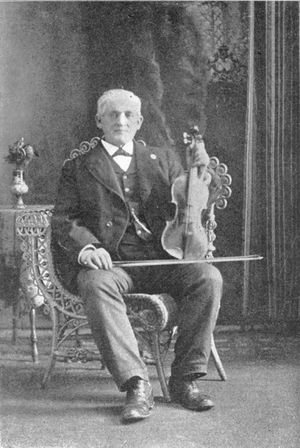Annotation:Doctor O'Neill (1): Difference between revisions
No edit summary |
m (Text replacement - "garamond, serif" to "sans-serif") |
||
| Line 1: | Line 1: | ||
=='''Back to [[{{BASEPAGENAME}}]]'''== | =='''Back to [[{{BASEPAGENAME}}]]'''== | ||
---- | ---- | ||
<p><font face=" | <p><font face="sans-serif" size="4"> | ||
'''DOCTOR O'NEILL [1]''' (An Doctur/Doctuir Ua Niall/Neill). Irish, Double Jig. D Major. Standard tuning (fiddle). AABBCCDDEE. Francis O'Neill ('''Irish Folk Music''', 1910) says that the tune "created a sensation" when introduced to Chicago traditional musicians and dancers ("who had never heard" it before) by the elderly fiddler Edward Cronin, originally from Limerick Junction, County Tipperary. O'Neill thinks it "quite probable" it had originally been a clan march. O'Neill captured a performance of the tune dating to around 1903 on a wax cylinder recording he made of the playing of Chicago fiddler John McFadden. | '''DOCTOR O'NEILL [1]''' (An Doctur/Doctuir Ua Niall/Neill). Irish, Double Jig. D Major. Standard tuning (fiddle). AABBCCDDEE. Francis O'Neill ('''Irish Folk Music''', 1910) says that the tune "created a sensation" when introduced to Chicago traditional musicians and dancers ("who had never heard" it before) by the elderly fiddler Edward Cronin, originally from Limerick Junction, County Tipperary. O'Neill thinks it "quite probable" it had originally been a clan march. O'Neill captured a performance of the tune dating to around 1903 on a wax cylinder recording he made of the playing of Chicago fiddler John McFadden. | ||
<br> | <br> | ||
<br> | <br> | ||
</font></p> | </font></p> | ||
<p><font face=" | <p><font face="sans-serif" size="4"> | ||
[[File:cronin.jpg|300px|thumb|right|Edward Cronin]] | [[File:cronin.jpg|300px|thumb|right|Edward Cronin]] | ||
''Source for notated version'': "Cronin" [O'Neill]. Chicago fiddler Edward Cronin was born in the 1840's in Limerick Junction, County Tipperary, and was one of the finest fiddlers in the city in O'Neill's time. He had a large repertoire of tunes and allowed O'Neill to transcribe many of them in weekly visits for several years. Unfortunately, Cronin could also be suspicious, and tended to hold grudges. O'Neill's transcribing with him came to an abrupt halt when Cronin perceived he had been slighted in some way. | ''Source for notated version'': "Cronin" [O'Neill]. Chicago fiddler Edward Cronin was born in the 1840's in Limerick Junction, County Tipperary, and was one of the finest fiddlers in the city in O'Neill's time. He had a large repertoire of tunes and allowed O'Neill to transcribe many of them in weekly visits for several years. Unfortunately, Cronin could also be suspicious, and tended to hold grudges. O'Neill's transcribing with him came to an abrupt halt when Cronin perceived he had been slighted in some way. | ||
| Line 12: | Line 12: | ||
<br> | <br> | ||
</font></p> | </font></p> | ||
<p><font face=" | <p><font face="sans-serif" size="4"> | ||
''Printed sources'': O'Neill ('''O'Neill's Irish Music'''), 1915; No. 135, p. 78. O'Neill (Krassen), 1976; p. 18. O'Neill ('''Music of Ireland: 1850 Melodies'''), 1903; No. 701, p. 130. O'Neill ('''Dance Music of Ireland: 1001 Gems'''), 1907; No. 6, p. 18. | ''Printed sources'': O'Neill ('''O'Neill's Irish Music'''), 1915; No. 135, p. 78. O'Neill (Krassen), 1976; p. 18. O'Neill ('''Music of Ireland: 1850 Melodies'''), 1903; No. 701, p. 130. O'Neill ('''Dance Music of Ireland: 1001 Gems'''), 1907; No. 6, p. 18. | ||
<br> | <br> | ||
<br> | <br> | ||
</font></p> | </font></p> | ||
<p><font face=" | <p><font face="sans-serif" size="4"> | ||
''Recorded sources'': <font color=teal>Comhaltas Ceoltoiri CL13, Tommy Peoples.</font> See also listing at Alan Ng's Irishtune.info [http://www.irishtune.info/tune/523/]. | ''Recorded sources'': <font color=teal>Comhaltas Ceoltoiri CL13, Tommy Peoples.</font> See also listing at Alan Ng's Irishtune.info [http://www.irishtune.info/tune/523/]. | ||
</font></p> | </font></p> | ||
Revision as of 12:14, 6 May 2019
Back to Doctor O'Neill (1)
DOCTOR O'NEILL [1] (An Doctur/Doctuir Ua Niall/Neill). Irish, Double Jig. D Major. Standard tuning (fiddle). AABBCCDDEE. Francis O'Neill (Irish Folk Music, 1910) says that the tune "created a sensation" when introduced to Chicago traditional musicians and dancers ("who had never heard" it before) by the elderly fiddler Edward Cronin, originally from Limerick Junction, County Tipperary. O'Neill thinks it "quite probable" it had originally been a clan march. O'Neill captured a performance of the tune dating to around 1903 on a wax cylinder recording he made of the playing of Chicago fiddler John McFadden.

Source for notated version: "Cronin" [O'Neill]. Chicago fiddler Edward Cronin was born in the 1840's in Limerick Junction, County Tipperary, and was one of the finest fiddlers in the city in O'Neill's time. He had a large repertoire of tunes and allowed O'Neill to transcribe many of them in weekly visits for several years. Unfortunately, Cronin could also be suspicious, and tended to hold grudges. O'Neill's transcribing with him came to an abrupt halt when Cronin perceived he had been slighted in some way.
Printed sources: O'Neill (O'Neill's Irish Music), 1915; No. 135, p. 78. O'Neill (Krassen), 1976; p. 18. O'Neill (Music of Ireland: 1850 Melodies), 1903; No. 701, p. 130. O'Neill (Dance Music of Ireland: 1001 Gems), 1907; No. 6, p. 18.
Recorded sources: Comhaltas Ceoltoiri CL13, Tommy Peoples. See also listing at Alan Ng's Irishtune.info [1].
